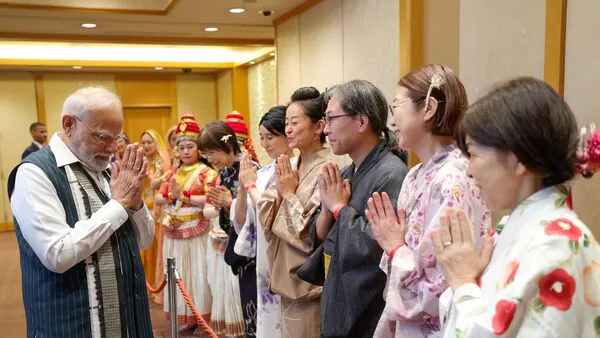PM Modi In Tokyo: Buddhism, Bullet Trains, And Big Business A Timeline Of Centuries-Old India-Japan Ties
| India's export to Japan (USD Billion) | 4.43 | 6.18 | 5.46 | 5.15 | 5.1 |
| India's import from Japan (USD Billion) | 10.9 | 14.39 | 16.49 | 17.69 | 15.9 |
| India-Japan bilateral trade (USD Billion) | 15.33 | 20.57 | 21.96 | 22.85 | 21 |
India ranks 11th in Japan's total exports with a 2.2 per cent share and 25th in India's total exports with a 1.2 per cent share. India ranks 28th in Japan's total imports with a 0.7% share and 12th in India's total imports with a2.6% share. India's total trade with Japan in FY24-25 (Apr'24 – Jan'25) is USD 21 billion, with Exports of USD 5.1 billion and Imports of USD 15.9 billion.
Some bits of HistoryThe exchange between Japan and India is said to have begun in the 6th century when Buddhism was introduced to Japan, according to the Ministry of Foreign Affairs of Japan
“Indian culture, filtered through Buddhism, has had a great impact on Japanese culture, and this is the source of the Japanese people's sense of closeness to India,” the Ministry says.
In 1949, after World War II, Prime Minister Jawaharlal Nehru donated an Indian elephant to the Ueno Zoo in Tokyo. The ministry says this brought a ray of light into the lives of the Japanese people who still had not recovered from defeat in the war. Japan and India signed a peace treaty and established diplomatic relations on 28 April 1952.
Also Read | India, Japan discuss working together in 3rd countriesThis treaty was one of the first peace treaties Japan signed after World War II, the ministry says.
Ever since the establishment of diplomatic relations, the two countries have enjoyed cordial relations. In the post-World War II period, India's iron ore greatly helped Japan recover from the devastation. Following Japanese Prime Minister Nobusuke Kishi's visit to India in 1957, Japan started providing yen loans to India in 1958, the first yen loan aid extended by the Japanese government.
Japan has always been an important partner in India's development journey. From metro rail to manufacturing, semiconductors to startups...
According to the Ministry of External Affairs , PM Modi's visit will consolidate the longstanding friendship between India and Japan, open new avenues for cooperation, and reaffirm both countries' shared commitment to peace, prosperity, and stability in the Indo-Pacific region and beyond.
Semiconductors, bullet trainsOn Saturday, Prime Ministers Narendra Modi and Ishiba are also expected to take a tour of Tokyo Electron Factory, the famed Japanese electronics and semiconductor company headquartered in Akasaka.
The Japanese Foreign Ministry has announced that the two leaders will also travel to Miyagi Prefecture on 30 August to inspect the Tohoku Shinkansen plant in Sendai.
The leaders are expected to sign an agreement on the introduction of Japanese E-10 coaches, to be transferred to India in 2030 for the Mumbai-Ahmedabad High Speed Rail or the 'Bullet Train ' project.
Towards the end of his remarks at the India-Japan Economic Forum on Friday, PM Narendra Modi made his 'Make-in-India' pitch, saying,“come, make-in-India, and make for the world....” as he highlighted the importance of technology and innovation.
(With agency inputs)
Key Takeaways
Legal Disclaimer:
MENAFN provides the
information “as is” without warranty of any kind. We do not accept
any responsibility or liability for the accuracy, content, images,
videos, licenses, completeness, legality, or reliability of the information
contained in this article. If you have any complaints or copyright
issues related to this article, kindly contact the provider above.
Most popular stories
Market Research

- Invromining Expands Multi-Asset Mining Platform, Launches New AI-Driven Infrastructure
- Superconducting Materials Market Size, Trends, Global Industry Overview, Growth And Forecast 2025-2033
- United States Lubricants Market Growth Opportunities & Share Dynamics 20252033
- Building Automation System Market Size, Industry Overview, Latest Insights And Forecast 2025-2033
- Brazil Edtech Market Size, Share, Trends, And Forecast 2025-2033
- Australia Automotive Market Size, Share, Trends, Growth And Opportunity Analysis 2025-2033






















Comments
No comment